There is no scope of taking decisions based on assumptions, especially when it comes to business.
Even if you take any action based on assumptions, you have to test them. There is no way of ignoring this.
Likewise, before investing lots of time, effort, and money, a business needs to understand what their target audience wants.
That is where most of the organizations fail to do. They start doing everything that comes under the sky. They start business blogs, create videos, integrate podcasts, creating infographics, and everything that they can think about.
I also understand that excitement.
But the fact is choosing the smart way is going to give you better and faster results as well.
Here the smart way is understanding what your audience actually wants.
- What type of content format do they prefer? Is it blog posts, YouTube videos, or podcasts?
- What are the platforms that they mostly use to consume content?
The goal is to get as accurate results as possible in terms of choosing the right content format and channels.
And when it comes to accuracy, the more data you have, the better decision you’ll take.
To perform extensive research, you need to consider five factors.
- Data-Based Research
- The goal of your Content
- Demographics
- Expertise/ Skill
- Budget/ Resources
Let’s understand how you can leverage each of these methods.
Data-Based Research

What can be better than data and statistics about audience behaviour?
This step will allow you to gain more accurate insights about customer interest and behaviour.
To make it simple, let’s divide the data-based research method into two parts.
One is quantitative, and the other one is qualitative research.
Qualitative Research
Social-Media:
Qualitative is all about getting information about your customers’ preferences by observing and performing questionnaires. In this case, you’ll use social media.
If your business has already social media profiles, then look for the comment, recommendations.
A comment section is social media is probably the best place to understand the customers’ pain points.
That could even include negative responses towards your product or service as well. When looking for the comment or other feedback on social media, observe what type of content they prefer the most.
Are they talking about how-to guides, tutorial videos, or what?
You can directly connect with your customers through social media posts, asking about how do they like to consume your content.
For instance, someone posted a comment on a Yoga picture saying, “Can you suggest me how to lose weight with Yoga”.
That simply means that the person is looking for an informational type of content.
This could be an educational blog post, or it could be tutorial video as well.
At this stage, you’re not going to get a clear answer about the content format or content platforms.
What you need to do is take down all the queries, questions, or even feedbacks from social media that helps to understand which content types, they prefer most.
And what type of content can help your audience to solve any particular problem?
For instance, writing a blog post on how to wear a tie is not going to work.
Why?
Because understanding how to wear a tie from an article is super hard. So, a video tutorial or infographics can make it easy.
In case you don’t have any huge social media fanbase, you can start with as small as possible.
Even a group of 200 people will also give you some amount of insights about their preferences.
Another way to do this when you have no follower base is by observing other social media profiles related to your industry.
You must look for the relevancy of the page that you’re going to use.
Their target audience must be as similar as yours.
Go to these social pages and observe what type of content they are preferring. Also, look for the most common content types.
Do they mostly publish long-form blog posts or videos?
If they are doing text, audio, and video-based content, then notice which content format is getting the most engagement, likes, and social shares as well?
That way, you’ll realize what is working best and what is not getting enough engagement as others?
Communication:
The most effort taking the most reliable method yet is to engage with your customers directly. If you have a customer care department, ask them to have a one on one call with your customers.
Some of the questions that you might ask are listed below:
- How much time do you spend on social media per day?
- What do you prefer most, YouTube Videos or Blog posts, or both?
- Would you like to get a weekly newsletter?
- Do you prefer listening to podcasts in your spare time?
Just like 1:1 communication, you can also host customer meetups programs or a seminar.
Organizing meetups will save you lots of time as you can interact with many people at the same time.
Quantitative Research
That is where the real fun begins as you’ll start seeing your target audience’s preferences on paper.
Remember that your job will be to collect as much data as possible to understand which type of content to focus on most. The quantitative data analysis will give you insights that you can measure and compare with others.
So, even if you have to choose between qualitative and quantitative methods, never miss out on the numerical data, though I recommend both to apply.
Google Trend:

Google Trend, the most underrated free tool, is what you need to have a better understanding of your audience.
In case you’re unfamiliar with the Google trend, here is a quick overview.
Google trend is an online free tool that gives insights about the popularity of any search term within a specific period for a specific region. And the best part is that you can compare the popularity of multiple keywords graphically.
By using this cool tool, you can even discover the popularity of a search query for different platforms such as Google, search, YouTube, Google News, Google Images, and Google shopping as well.
So how to get most of the Google trend? (I’m sure this is not how you usually do it)
Let’s start with my favourite niche, that is content marketing.
Just go to the Google trend home page. Then type your keyword related to your industry.
Learn more about keyword optimization.
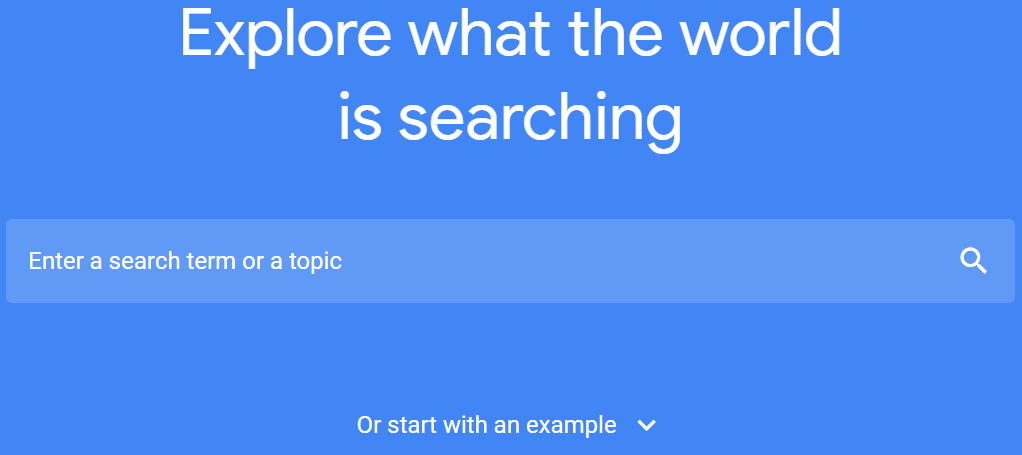
In my case, my industry is related to content marketing. Now click enter.
Here’s how it looks like.
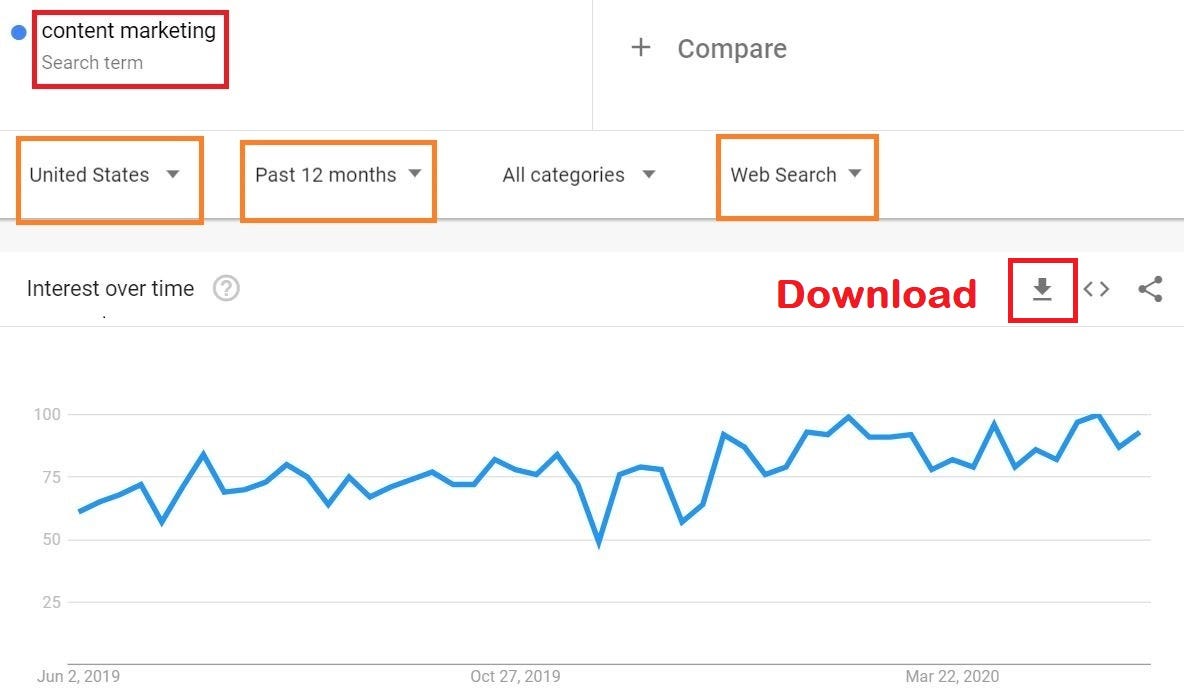
You can see the popularity graph for the term ‘content marketing’. By default, it will choose the country and time period as the United States and the last 12 months as respectively.
So, if your business is not restricted to any place, then you can choose for the worldwide data; otherwise, just select a specific country to get the desired result.
Likewise, you can change the time period for your search term and also the search preferences.
I would recommend you choose at least the last 12 months to understand the stability and pattern for the search term that you’ve just entered. Also, don’t forget to select the ‘web search’ for your search.
So how could you understand which content format or content channels to choose for your business?
I would say Wait for a little more!
We are yet to discover the best. It has just started now.
Next, once you get a popularity graph for a specific time range, region, and search term, download the data for web search. It will be downloaded as a .csv file.

Now, it will show you the search interest for your term over the YouTube platform.

Now similarly, download the data for the YouTube platform.
Here comes the exciting part that is comparing.
We are trying to compare the data (popularity of a search term) of the YouTube platform with Web (Google search) platform.
Let’s start comparing the data.
Open both of these downloaded data (.csv file for YouTube and Web Search) in excel. Let me clarify again that till now you have downloaded two (.CSV) files (one for YouTube and second for Web search).
Now create a separate excel sheet where you’ll just simply paste the data from the previous two.CSV files.
You’ll get to see like this in excel.
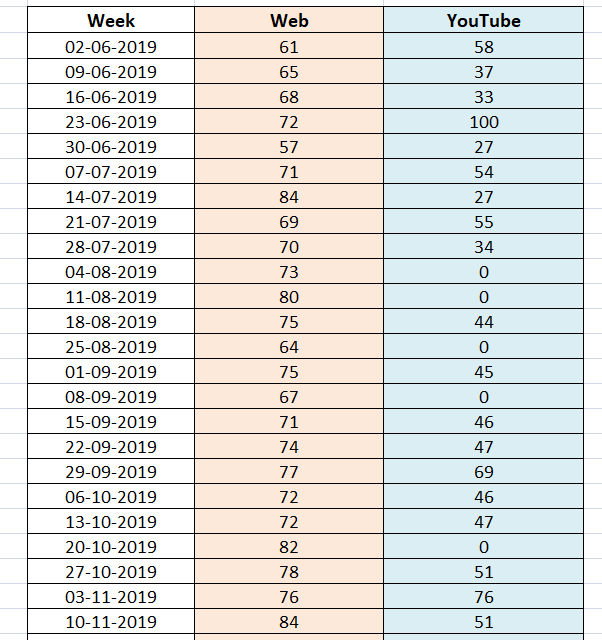
Now, select all the data from column ‘Web’ and ‘YouTube’ and then click on the insert from the top bar menu.
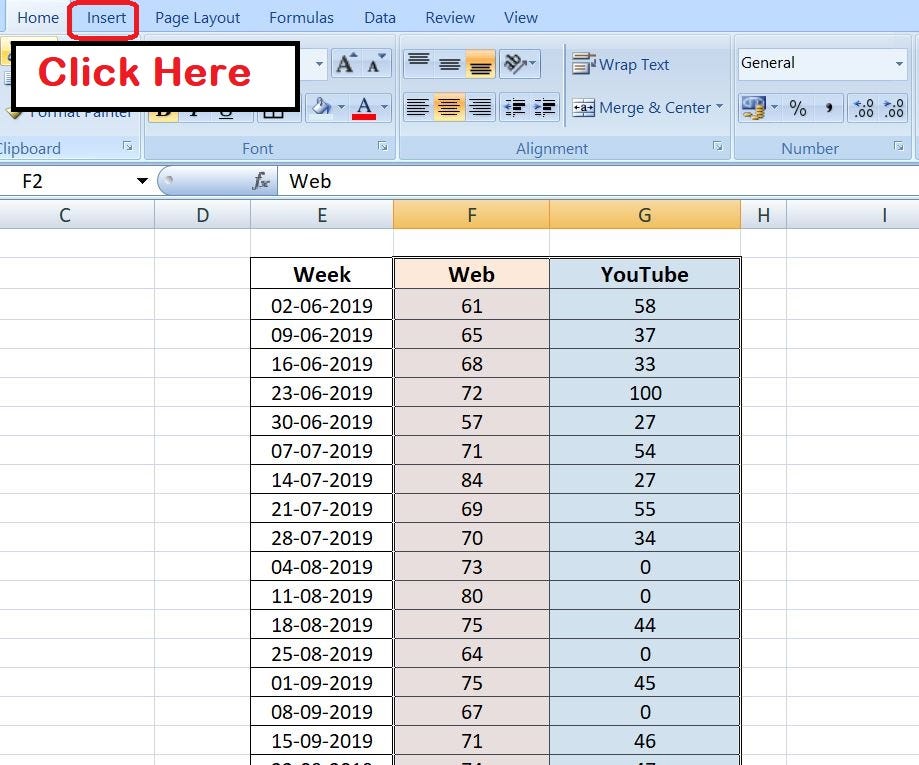
Then click on Line and select any form from the 2D Line.
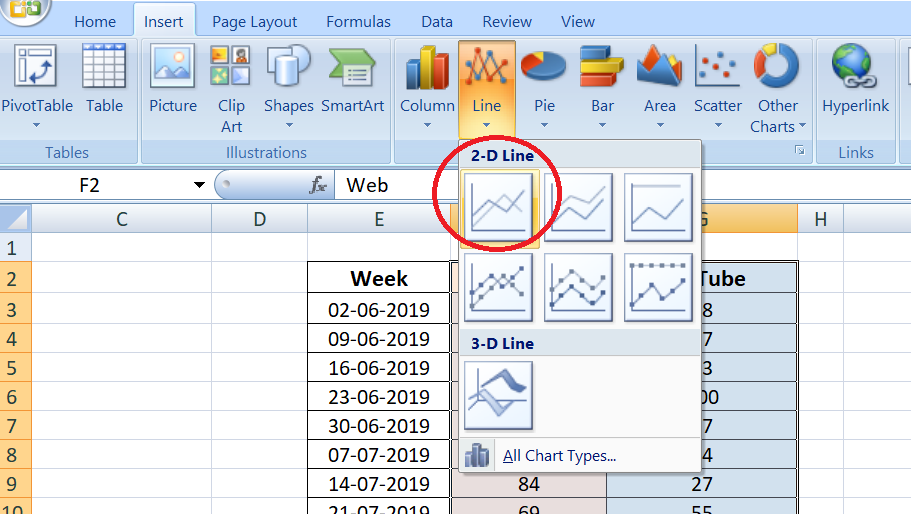
Now you’ll get to see the result of the search popularity of your keyword in two different search platforms.
In this case, it is YouTube search vs Google Search.
Let me show you the data I got from the comparison.
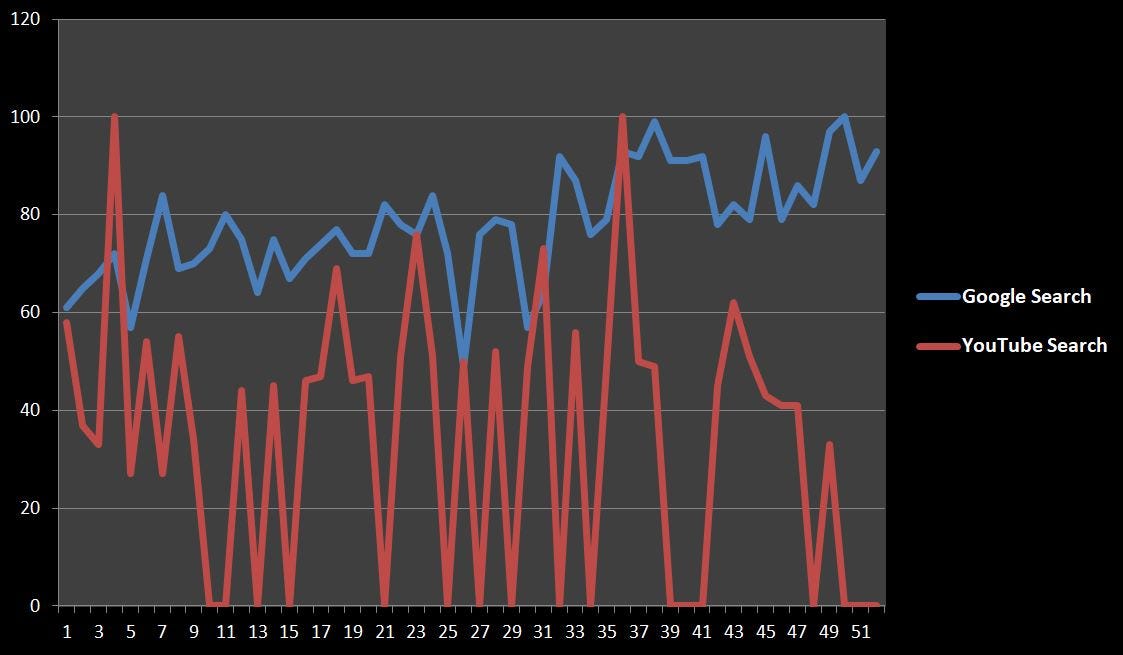
The gap between each value of the horizontal axis represents a weak/7 days, whereas the vertical axis divided as 0 to 100.
0 is for the lowest search query recorded for that term and, 100 shows the maximum search query happened for the key term.
So what does this graph of comparison mean?
Here are the learnings or conclusions that I can conclude by seeing the graph.
- The majority of the people of the United States are searching for the term ‘content marketing’ in Google search, not in Youtube search.
- People are more likely to consume content about content marketing from Google instead of YouTube. This means most of the people are preferring blog posts over YouTube.
- Chances are YouTube doesn’t have much content about content marketing as compared to Google.
- People of the United States are highly interested in content marketing over the last 12 months.
Now, its time to decide based on data, not on assumptions.
If my target audience is in the United States, then I might give more priority to blog posts content as compared to YouTube videos.
This is because most of the people from the US are searching for content marketing on Google.
So give it a try for your industry and target location as well.
But don’t just depend on this method, even though this is a great way to identify the content opportunity.
Remember the more data you will gather, the better decision you will take.
This brings me to the next method, which is competitor analysis.
competitor Analysis

From local businesses to large-sized organizations, every business has its own competition. But having competition is not a bad idea, especially when it comes to identifying the right content formats.
The first thing that you can do is create a list of three giants in your industry. Now your next job is to understand what are they doing in terms of content.
You may notice some are aggressive on creating short-form videos, whereas others still building an audience using blog posts. It could vary organization to organization.
Now, to have an insight into what your competitors are doing, you need to notice which platform are they most active on.
Is it YouTube? Or is it podcasts? Or even other formats as well.
Have a close look at what content platform is giving them the maximum leads.
What most of the businesses do mistake is that they just try to leverage the content format or even platforms just because others are doing.
But the smart way is to look at the maximum engagement. If it is blog posts, look for the backlinks, shares, traffic that their content is getting.
The KPI in this method is content engagement (Likes, comments, shares, backlinks, etc.).
You can use tools like Ahrefs, semrush, UberSuggest or any other premium tool to get the most accurate results.
Likewise, look for the podcasts and video format as well.
This will also help you in understanding which platform is working best for them.
As long as your target audience is similar to your competitors, you can trust the numbers of maximum engagement for each content format.
Along with the competitor analysis, you can also use BuzzSumo tool.
This tool allows you to understand what type of content is getting more engagement and social shares.
It also gives you results based on content platforms such as Google, Facebook, youtube.
Now, create a list of content formats and rank them according to the maximum number of shares on each of the content platforms.
Let’s say if eBooks are getting the maximum attention from the audience of your competitor, then it is more likely to invest time and effort in going for creating valuable eBooks.
Why?
Because it’s already tested by your competitor, that way you can focus on the jobs that are already giving maximum Return-On-Audience.
Poll and survey
This is mostly helpful for businesses that already have an audience base. The simplest way is to run a poll on every social media as possible.
Remember the more data you have, the more clear your decision will be.
Even not only businesses but also freelancers and personal brands are utilizing the power of social media platforms.
And the fastest and easiest way to understand their audience is by running a poll on social platforms.
I have seen more engagement in polls as compared to asking for direct feedback, maybe because it just takes a click to participate in a poll.
Whatever the reason it is, you must get the most out of this.
If you don’t have an audience yet, then a paid survey or poll is not a bad idea also.
Tools like survey monkey and even Facebook Ads can help you in this as well.
Content Goal

The content goal is the target that you want to achieve with your content.
Every piece of content must play an individual role. It could be of generating leads or brand awareness or thought leadership.
By following what’s working in your industry, you can start focusing on specific content types for specific goals.
First, you need to identify the goal that you want to accomplish with your content.
Yes, your brand may have multiple goals to achieve using content marketing. In that case, dividing content format for each of the goals is the smart way of organizing your content calendar.
Here’s the list that describes the possible content format based on content goals.
| Content Goal | Content Format |
| Brand Awareness | Educational content (Blog posts, video guides, eBooks, Social media posts, how-to-guides, etc.) |
| Lead Generation | eBooks, Templates, Podcasts, Product trial, etc. |
| Thought leadership | White papers, Video tutorial, presentation, Infographics, etc. |
| Conversion/Sales | Product demo, FAQ, Free consultation, etc. |
| Backlinks, shares | Research paper, Infographic posts, Case study, etc. |
Understanding content is also important for creating content based on the buyer’s journey.
The buyer’s stages consist of stages that every buyer goes through.
From knowing your brand to buying from your product or service, the overall journey is categorized into three stages.
Three stages of the buyer’s journey are-
- Awareness stage: When the buyer is looking for a clear idea about a specific problem.
- Consideration stage: After getting a clear picture of the problem, now, the buyer is looking for solutions.
- Decision stage: When the buyer is looking for the best solutions.
So what’s the point in knowing different buyer’s stages?
It’s because you must plan your content by considering the buyer’s journey.
Now, the below list will show you the content guide for each of the stages.
| Buyer’s Stage | Content Types |
| Awareness stage | How-to posts, Long-form blog posts, Video Guides, |
| Consideration stage | FAQ articles, Demo videos, Case study, etc. |
| Decision stage | Free trial, Articles guides for your product or service, Consultation, etc. |
Demographics

Demographics is one of the key aspects of understanding the customer avatar.
A customer avatar is a set of characteristics, interests, behaviour, and other information of your ideal customers.
It includes much information so that you can have a clear understanding of who is your customer, what do they want, and other information as well.
Demographics can show you a clear picture of what type of content format or content channel do they prefer more in the future.
A study made by HubSpot centre discloses a result on the preference of content format based on age.
As per the report, the younger audience (18–24) highly recommends video content, whereas older (55 or older) are still preferring emails.
Here’s the full report: Content trends
Again, social media posts are more popular between the younger generation (18–34).
You can use these reports to understand what is trending and what are the content formats that they’re preferring.
Budget and Resources

Looking for the available resources is also a key factor that you cannot afford to ignore. Because content marketing is a marathon which means that you just cannot give up in the middle of the journey.
That is why sticking with one or two content format for the long term is quite important.
It takes lots of time, effort, and money to create, publish and distribute valuable, compelling, and relevant content.
I have seen some of the organizations that are trying to do everything, everything that comes under the sky.
Just because they don’t have any strategic plan and approach, they end up either give up in the mid-way or continuing to create content cheaply, fastly, and easily.
For instance, videos are the most expensive to produce, whereas articles can be the least expensive. Don’t just try to create videos when you cannot provide valuable and high-quality content through it.
This is what you need to avoid. You must if you want to take your game for the long term.
Look for the total budget that you afford in content marketing. According to this, you can decide which format your company can produce in the long run.
Expertise or Skill
Having expertise in the content topic is a must for the content creators. Even if you, as a founder of the company, is not an expert in that field, then you must not try to create content for your audience.
Knowledge and expertise play a vital role in creating valuable content. Look at the content marketing team.
Are there any experts in the house? If the is No, then you must outsource your content.
You just don’t want to invest your time in creating content that doesn’t add much value to your audience.
Hence, invest in quality over quantity.
A few more words
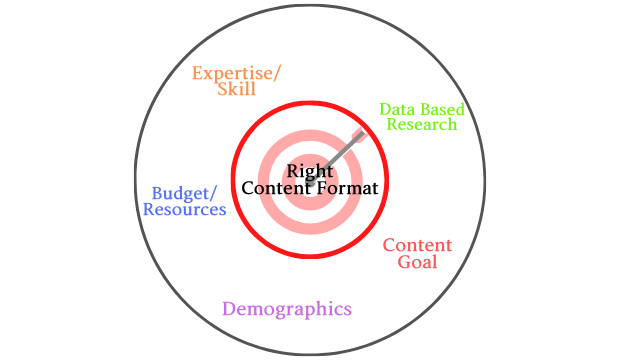
Choosing the right content format and stick to it for a long time is a challenging task. It must start with a solid foundation.
The key thing is to stay consistent with your content format.
And, decision-based on data and research will help you in reducing the chances of error. Whenever you try to figure out which content format to select, give these methods a try.
Another tip that I would like to share with you is that you always build an audience where you have full control.
Having millions of social media followers is good, but you shouldn’t fully depend on this. You never know when you lost all of your followers in a second.
Social media platforms are going to keep coming in the future days, but when you build your personal empire, you don’t need to worry about what’s going to happen tomorrow.
Building an email list is a way of creating an audience base with full control, and you should never avoid it, even though you’re creating only YouTube videos.
That’s all for today. Please share your thoughts in the comment

Sk Rafiqul Islam is a content marketing practitioner with 3+ years of practical experience. He spends most of his time helping businesses to build a loyal audience with content marketing. He is also running a tech career blog called 10Pie and content marketing VIP, a bi-weekly marketing newsletter. In his free time, he loves reading books and playing football.
